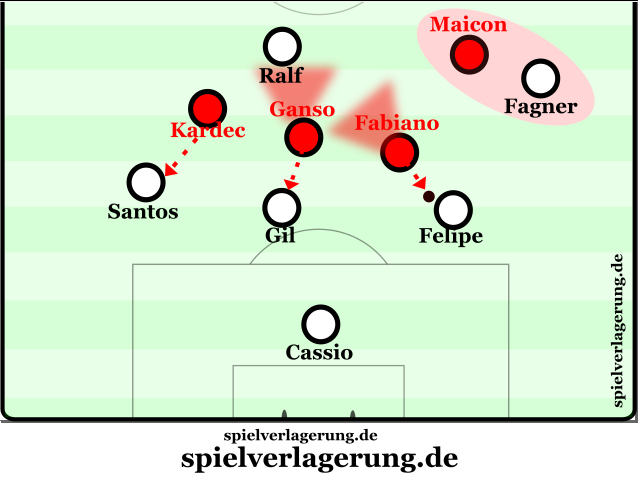Corinthians – Sao Paulo 2:0
This match was probably the most highly anticipated Copa Libertadores match of this week due to the nature of the rivalry between the two Brazilian giants as well as the clubs being among the most successful in recent Libertadores history, each winning the competition within the last ten years.
Both sides were without their big-name strikers with Paolo Guerrero being ruled out because of a red card he picked up in the qualifying round, while Alexandre Pato was ineligible to face Corinthians–the club he is on loan to Sao Paulo from.
Man-to-man marking
Man-to-man marking is more widely used in South America than it is in Europe. Both sides used variants of it in this match and experienced different results.
Sao Paulo used a strict man-to-man marking system which was exposed by Corinthians for the opening goal of the match. Fagner, Jadson, Danilo and Elias linked up well in the center-right/right halfspace area in Sao Paulo’s half dragging their markers out of an area, which another would drag their marker into. This created the space for Elias to move into the penalty area and connect with a Jadson cross to put Corinthians one up. Most of said movement was vertical rather than horizontal. This meant that it was not as much of a risk as for example, putting four men on the last line in hope of creating space in the defence with horizontal movements.
Corinthians weren’t intent on disrupting Sao Paulo’s deeper build-up however they did opt for a situational man-marking variant. They allowed Sao Paulo’s centre-backs (and Denilson, who often dropped to allow the CBs to spread and the FBs to push up the field) to pass side-to-side but every time Ganso, Fabiano, or Kardec dropped to pick up the ball, either Gil, Felipe, or Ralf would stick tight to them to prevent a turn. Corinthians outlined Ganso in particular as a threat as when he dropped to receive the ball, he would be pressed three ways by Corinthian’s midfield inverted triangle.
Corinthians’ man-marking did restrict them in attack. The wide men, Emerson and Jadson were tasked with sticking with the opposition full-back if they pushed too far up the pitch in an attempt to exploit the open flank that was left due to Corinthians’ narrow back four. This meant that Emerson and Jadson were often pinned back by the Sao Paulo fullbacks which meant Corinthians were a lot less dangerous in the attacking transition.
The potential of Corinthians’ counterattack was shown as they broke at pace from a cleared Sao Paulo corner and made it 2-0 at the midway point of the second half. It’s a shame this could not have been replicated more often,
Sao Paulo’s domination of possession
Despite controlling the early stages of the match, Corinthians were happy to sit back after their 12th minute goal. In fact, they didn’t register a single shot in the first half after the 14th minute.
Throughout the whole match Corinthians actually had sixteen shots, five of which on target, while Sao Paulo had nine shots with only one on target. However, Sao Paulo had 60% of possession. So where did it go wrong?
As I have already mentioned, Corinthians let Sao Paulo take their time when building up. This was contrary to Sao Paulo who pressed Corinthians as shown below. This forced Corinthians, who weren’t keen on Ralf dropping to collect the ball from the centre-backs, to play long.

Fabiano, Ganso and Kardec press the defence while cover shadowing Ralf. Maicon is tight to Fagner, who tended to play more advanced.
Corinthians tend to prefer to play with this style anyway and aimed most of their long balls wide to Emerson, who would offload inside to shift the pressure. This didn’t really create any goal scoring opportunities for Corinthians, it was merely a method of clearance.
The main reason Sao Paulo didn’t turn their possession into chances is their dreadful creativity in the final third. Their most creative player, Ganso, was restricted well by Ralf while Luis Fabiano’s movement was non-existent. They simply relied on crosses. It was like watching Moyes’ Manchester United as they played in cross after cross. Santos or Fagner went out to meet the crosser while the other three defenders stayed very tight. This, of course, completely opened up the halfspace but Sao Paulo failed to penetrate this space. This could have easily been done simply with penetrating runs from Maicon or Souza, or underlaps by the fullbacks.
Also, their only width came through their fullbacks, who would not be high up the pitch when Corinthians (and any team) are most vulnerable, in transition.
Conclusion
This match demonstrated the positives and negatives of man-to-man marking as well as again showing that possession is only useful when applied properly.
The result puts the two Sao Paulo-based teams top and bottom of group two after one match with San Lorenzo and Danubio to play each other in their first match later today.
It was also a worrying sign for the other Brazilian teams in the competition as most leagues around South America are in full-swing, while the Brazilian teams are still playing in their regional tournaments. This was obvious due to some of the poor technical, physical and tactical play in Sao Paulo. Atletico Mineiro and Internacional also suffered defeats in their opening match of this year’s Copa Libertadores.

Keine Kommentare vorhanden Alle anzeigen